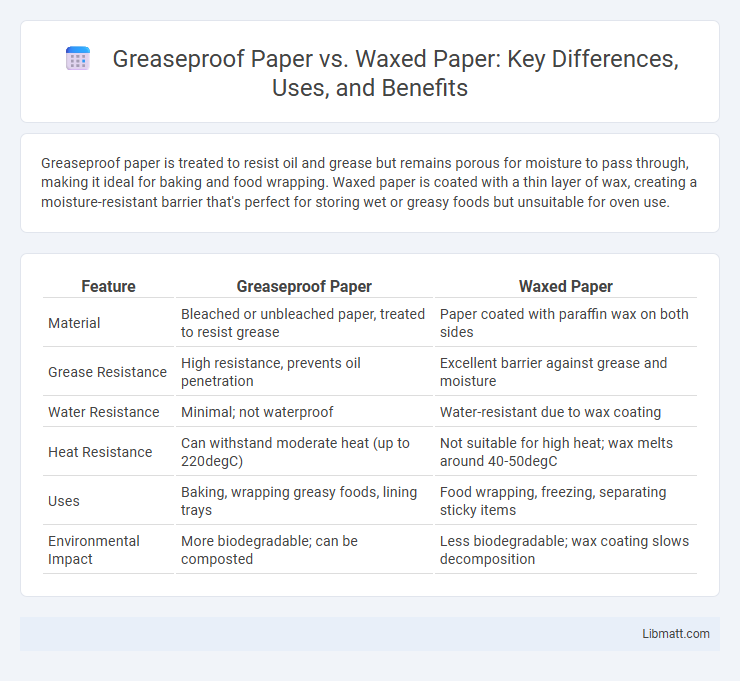Greaseproof paper is treated to resist oil and grease but remains porous for moisture to pass through, making it ideal for baking and food wrapping. Waxed paper is coated with a thin layer of wax, creating a moisture-resistant barrier that's perfect for storing wet or greasy foods but unsuitable for oven use.
Table of Comparison
| Feature | Greaseproof Paper | Waxed Paper |
|---|---|---|
| Material | Bleached or unbleached paper, treated to resist grease | Paper coated with paraffin wax on both sides |
| Grease Resistance | High resistance, prevents oil penetration | Excellent barrier against grease and moisture |
| Water Resistance | Minimal; not waterproof | Water-resistant due to wax coating |
| Heat Resistance | Can withstand moderate heat (up to 220degC) | Not suitable for high heat; wax melts around 40-50degC |
| Uses | Baking, wrapping greasy foods, lining trays | Food wrapping, freezing, separating sticky items |
| Environmental Impact | More biodegradable; can be composted | Less biodegradable; wax coating slows decomposition |
Introduction to Greaseproof Paper and Waxed Paper
Greaseproof paper is a lightweight, air- and grease-resistant paper used primarily in baking and food wrapping to prevent oil and moisture seepage. Waxed paper is coated with a thin layer of paraffin wax, making it waterproof and ideal for tasks like food storage and preparation but unsuitable for oven use due to melting. Understanding the distinct properties of greaseproof and waxed paper helps you select the right option for cooking, baking, and food preservation needs.
What is Greaseproof Paper?
Greaseproof paper is a specialized type of paper designed to resist grease and oil penetration, commonly used in baking and food packaging. It is manufactured by refining the paper fibers to create a dense, non-porous surface without the need for added coatings or wax. This paper's grease-resistant properties make it ideal for wrapping oily foods and lining baking trays, offering a natural alternative to waxed paper.
What is Waxed Paper?
Waxed paper is a type of kitchen paper coated with a thin layer of paraffin wax, making it moisture-resistant and non-stick. It is commonly used for wrapping food items or lining baking trays to prevent sticking and retain freshness. Your cooking and baking tasks benefit from waxed paper's ability to provide a reliable, grease-resistant barrier.
Key Differences Between Greaseproof and Waxed Paper
Greaseproof paper is made from highly refined paper pulp and treated to resist oil and grease penetration without adding any coating, making it porous and breathable. Waxed paper is coated with a thin layer of paraffin or soybean wax, providing a non-stick, moisture-resistant surface ideal for wrapping food but less heat-resistant than greaseproof paper. Unlike waxed paper, greaseproof paper can withstand higher oven temperatures without melting, making it preferred for baking applications.
Common Uses of Greaseproof Paper
Greaseproof paper is commonly used in baking and cooking for wrapping food items such as sandwiches, pastries, and candies due to its moisture-resistant and non-stick properties. It serves as a lining for baking trays and cake tins to prevent sticking and allow easy removal of baked goods. Greaseproof paper is also ideal for separating layers of delicate cookies or baked items to maintain freshness and prevent them from sticking together.
Common Uses of Waxed Paper
Waxed paper is commonly used for wrapping food items, preventing moisture and grease from seeping through, making it ideal for storing sandwiches and wrapping cheese. It is often utilized for lining baking pans and countertops to minimize sticking and facilitate easy cleanup, particularly with sticky or messy ingredients. You can also use waxed paper as a temporary cover for food in the microwave, as it resists moisture but is not heat-resistant enough for direct exposure in ovens.
Food Safety and Heat Resistance
Greaseproof paper offers superior food safety due to its natural resistance to oils and fats without chemical coatings, making it ideal for direct food contact and baking. Waxed paper, coated with a thin layer of wax, provides excellent moisture resistance but can melt or release fumes at high temperatures, limiting its heat resistance and suitability for oven use. Your choice should prioritize greaseproof paper for heat applications to ensure food safety and prevent contamination.
Environmental Impact: Greaseproof vs Waxed Paper
Greaseproof paper typically has a lower environmental impact than waxed paper because it is usually made from uncoated, biodegradable fibers that decompose more easily. Waxed paper is coated with paraffin wax, a petroleum-based product, which makes it less eco-friendly and more challenging to recycle or compost. Choosing greaseproof paper supports sustainability efforts by reducing reliance on nonrenewable resources and minimizing waste in your kitchen activities.
Which One Should You Choose?
Greaseproof paper is a better choice when you need a non-stick, moisture-resistant surface for baking or wrapping oily foods without adding any wax or additives. Waxed paper is ideal for storing or wrapping food that requires a moisture barrier but should not be heated, as the wax can melt and cause issues. Your decision depends on whether you need heat resistance and non-stick properties (greaseproof) or just moisture protection for cold storage (waxed).
Conclusion: Making the Right Choice
Greaseproof paper is ideal for baking and cooking as it resists oil and moisture without melting, while waxed paper provides a non-stick surface perfect for wrapping and storing food but should not be used in the oven due to its wax coating. Your selection depends on the specific cooking or food storage task, ensuring safety and optimal results. Understanding these differences helps you make the right choice between greaseproof and waxed paper for your kitchen needs.
Greaseproof paper vs waxed paper Infographic

 libmatt.com
libmatt.com